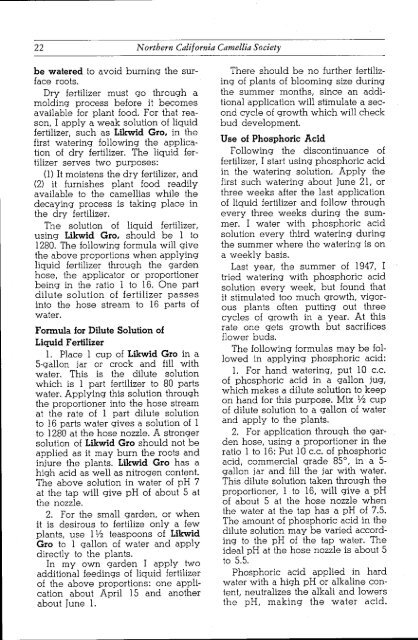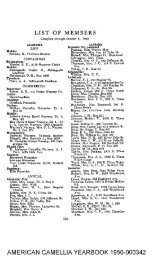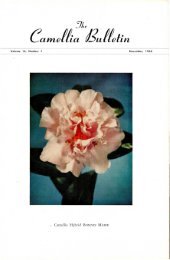CAMELLIA JAPONICA - GOVERNOR EARL WARREN - Immense ...
CAMELLIA JAPONICA - GOVERNOR EARL WARREN - Immense ...
CAMELLIA JAPONICA - GOVERNOR EARL WARREN - Immense ...
You also want an ePaper? Increase the reach of your titles
YUMPU automatically turns print PDFs into web optimized ePapers that Google loves.
22 Northern California Camellia Society<br />
be watered to avoid burning the surface<br />
roots.<br />
Dry fertilizer must go through a<br />
molding process before it becomes<br />
available for plant food. For that reason,<br />
I apply a weak solution of liquid<br />
fertilizer, such as Likwid Gro, in the<br />
first watering following the application<br />
of dry fertilizer. The liquid fertilizer<br />
serves two purposes:<br />
(l) It moistens the dry fertilizer, and<br />
(2) it furnishes plant food readily<br />
available to the camellias while the<br />
decaying process is taking place in<br />
the dry fertilizer.<br />
The solution of liquid fertilizer,<br />
using Likwid Gro, should be 1 to<br />
1280. The following formula will give<br />
the above proportions when applying<br />
liquid fertilizer through the garden<br />
hose, the applicator or proportioner<br />
being in the ratio 1 to 16. One part<br />
dilute solution of fertilizer passes<br />
into the hose stream to 16 parts of<br />
water.<br />
Formula for Dilute Solution of<br />
Liquid Fertilizer<br />
1. Place 1 cup of Likwid Gro in a<br />
5-gallon jar or crock and fill with<br />
water. This is the dilute solution<br />
which is 1 part fertilizer to 80 parts<br />
water. Applying this solution through<br />
the proportioner into the hose stream<br />
at the rate of 1 part dilute solution<br />
to 16 parts water gives a solution of 1<br />
to 1280 at the hose nozzle. A stronger<br />
solution of Likwid Gro should not be<br />
applied as it may burn the roots and<br />
injure the plants. Likwid Gro has a<br />
high acid as well as nitrogen content.<br />
The above solution in water of pH 7<br />
at the tap will give pH of about 5 at<br />
the nozzle.<br />
2. For the small garden, or when<br />
it is desirous to fertilize only a few<br />
plants, use 1Y2 teaspoons of Likwid<br />
Gro to 1 gallon of water and apply<br />
directly to the plants.<br />
In my own garden I apply two<br />
additional feedings of liquid fertilizer<br />
of the above proportions: one application<br />
about April 15 and another<br />
about June 1.<br />
There should be no further fertilizing<br />
of plants of blooming size during<br />
the summer months, since an additional<br />
application will stimulate a second<br />
cycle of growth which will check<br />
bud development.<br />
Use of Phosphoric Acid<br />
Following the discontinuance of<br />
fertilizer, I start using phosphoric acid<br />
in the watering solution. Apply the<br />
first such watering about June 21, or<br />
three weeks after the last application<br />
of liquid fertilizer and follow through<br />
every three weeks during the summer.<br />
I water with phosphoric acid<br />
solution every third watering during<br />
the summer where the watering is on<br />
a weekly basis.<br />
Last year, the summer of 1947, I<br />
tried watering with phosphoric acid<br />
solution every week, but found that<br />
it stimulated too much growth, vigorous<br />
plants often putting out three<br />
cycles of growth in a year. At this<br />
rate one gets growth but sacrifices<br />
flower buds.<br />
The following formulas may be followed<br />
in applying phosphoric acid:<br />
1. For hand watering, put 10 C.c.<br />
of phosphoric acid in a gallon jUg,<br />
which makes a dilute solution to keep<br />
on hand for this purpose. Mix Y2 cup<br />
of dilute solution to a gallon of water<br />
and apply to the plants.<br />
2. For application through the garden<br />
hose, using a proportioner in the<br />
ratio 1 to 16: Put 10 c.c. of phosphoric<br />
acid, commercial grade 85 0 , in a 5gallon<br />
jar and fill the jar with water.<br />
This dilute solution taken through the<br />
proportioner, 1 to 16, will give a pH<br />
of about 5 at the hose nozzle when<br />
the water at the tap has a pH of 7.5.<br />
The amount of phosphoric acid in the<br />
dilute solution may be varied according<br />
to the pH of the tap water. The<br />
ideal pH at the hose nozzle is about 5<br />
to 5.5.<br />
Phosphoric acid applied in hard<br />
water with a high pH or alkaline content,<br />
neutralizes the alkali and lowers<br />
the pH, making the water acid.




